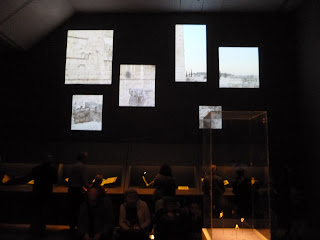
We all met on Friday for dinner to celebrate Mom's birthday. We drank champagne and celebrated, laughing and remembering some two decades of the these joint birthday parties between Mom and I since I moved here in 1997. The next morning we all made our way to the Met for the Jerusalem show at the Met. We took our time walking through this show about a city and a holy site for three world religious traditions. Searching for breath, Mom told us about the art of the crusades and the Church of the Annunciation in Nazareth. There was old St James. The expressionistic images from the old capitals, long buried, seemed to speak beyond time. So we walked and took in the manuscripts, maps, capitals, and illuminations.
Mom had to rest for much of the show, but she made it through, before going upstairs for lunch.
Over lunch, Mom recalled her first trip to Jerusalem in 1961. Her parents were gone. So she took a trip around the world, embarking from Atlanta, off to San Francisco, Hawii, Kawii, Tokoyo, Bangkok, Delhi, Jerusalem, Egypt, Munich, Vienna and back home. Bangkok was the highlight of her trip. But it was the beginning of a lifetime of travel, opening up her mind and consciousness to the rest of the world. Its been fifty-five years since she was last in Jerusalem. It was a joy to go back with her.
The Met situated the show:
Before we went upstairs, Caroline and I ran down to the first floor to explore Max Beckman's portraits, his pre war images of Berlin and occupied Amsterdam, before making his way to a New York City that he described as, "a prewar Berlin multiplied a hundredfold." We've loved this expression for years and years, feeling a closer kinship with this Berliner who made his way to Brooklyn to make a home.
The exhibition is made possible by The Isaacson-Draper Foundation.
It is supported by an Indemnity from the Federal Council on the Arts and the Humanities.
In late December 1950, Beckmann set out from his apartment on the Upper West Side of Manhattan to see his Self-Portrait in Blue Jacket (1950), which was on view at The Metropolitan Museum of Art in the exhibition American Painting Today. However, on the corner of 69th Street and Central Park West, the 66-year-old artist suffered a fatal heart attack and never made it to the Museum. The poignant circumstance of the artist’s death served as the inspiration for the exhibition.
During the late 1920s, Max Beckmann (1884–1950) was at the pinnacle of his career in Germany—his work was presented by prestigious art dealers; he taught at the Städel Art School in Frankfurt and moved in a circle of influential writers, critics, publishers, and collectors. After the National Socialists denounced his work as “degenerate” and confiscated it from German museums in 1937, Beckmann left the country and immigrated to Holland, where he remained for 10 years. After the war, and after rejecting offers to teach in Berlin and Munich, Beckmann accepted a temporary teaching position in Saint Louis, Missouri, in 1947. He made his move to America permanent in 1948, seeing his emigration as marking the end of his exile. In early September 1949 he moved to New York City, which he described as “a prewar Berlin multiplied a hundredfold,” and began teaching at the Brooklyn Museum Art School. He and his wife Mathilde “Quappi” Beckmann first lived at 234 East 19th Street, between Second and Third Avenues, moving in May 1950 to 38 West 69th Street, between Central Park West and Columbus Avenue. Life in Manhattan energized him and resulted in such powerful pictures as Falling Man (1950) and The Town (City Night) (1950).
Though Beckmann was new to the city, his work was not. Before his arrival, it had been known in New York for more than two decades through the efforts of two art dealers from Berlin, J. B. Neumann and Curt Valentin. Important paintings by the artist dating from the 1920s through the 1940s entered public and private collections in New York as a result of the close relationships Neumann and Valentin forged with collectors. Both dealers also befriended Alfred H. Barr, the director of the Museum of Modern Art from 1929 to 1943. With Barr, Neumann was instrumental in conceiving the museum’s exhibition German Painting and Sculpture in spring of 1931. Eight works by Beckmann dating from 1921 to 1929 were included in the exhibition.
Among the first private collectors of his work was the German-born Dr. Hirschland, who, before 1930, acquired from Neumann the important Self-Portrait on Yellow Ground with Cigarette (1923), which he bequeathed to the Museum of Modern Art in 1956. Abby Aldrich Rockefeller, one of the founders of the museum, in 1931 purchased Family Picture (1920) from Neumann; she then gave it to the Museum of Modern Art in 1935, where it was joined in 1942 by Barr’s purchase of the artist’s first triptych, Departure (1932, 1933–35). These early prominent collectors were followed by generations of others whose contributions will be on view in this exhibition at The Met.











































































































No comments:
Post a Comment